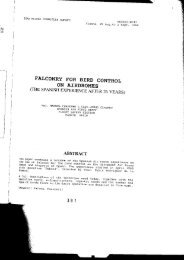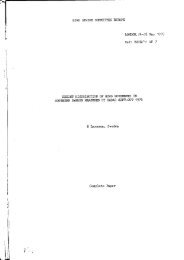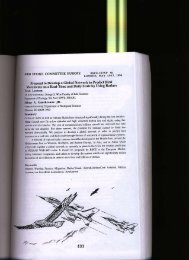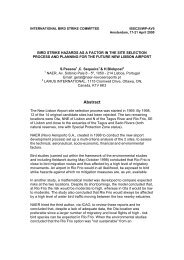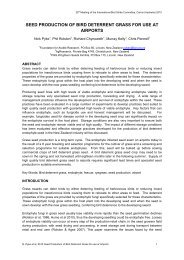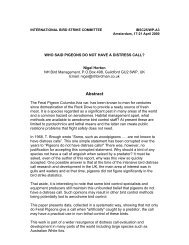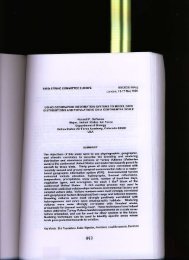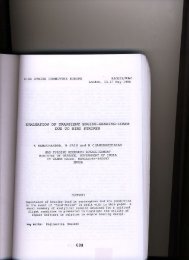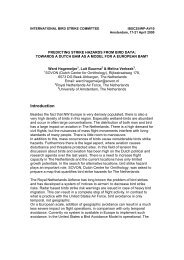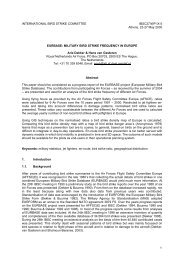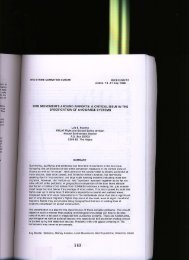Modelling the bird - International Bird Strike Committee
Modelling the bird - International Bird Strike Committee
Modelling the bird - International Bird Strike Committee
Create successful ePaper yourself
Turn your PDF publications into a flip-book with our unique Google optimized e-Paper software.
INTERNATIONAL BIRD STRIKE COMMITTEE<br />
IBSC27/WP VIII-3<br />
A<strong>the</strong>ns, 23-27 May 2005<br />
MODELLING THE BIRDSTRIKE RISK FROM HAZARDOUS BIRDS ATTRACTED TO RESTORED<br />
MINERAL EXTRACTION SITES.<br />
Andrew Paul Robinson<br />
Central Science Laboratory, Sand Hutton, York, YO41 1LZ, UK<br />
Tel:+44(0)01904462071, Fax:+44(0)01904462071, Email:a.robinson@csl.gov.uk<br />
Abstract<br />
Mineral extraction for sand and gravel is often concentrated in lowland river valleys near major towns<br />
and airports. Where restoration schemes for such sites include open water, <strong>the</strong>y frequently attract<br />
large numbers of waterfowl and o<strong>the</strong>r hazardous <strong>bird</strong> species that pose a <strong>bird</strong>strike risk to aircraft.<br />
There is a need, <strong>the</strong>refore, to predict <strong>the</strong> numbers of <strong>bird</strong>s likely to be attracted to a potential<br />
restoration and to assess how any movements will impact upon flight safety prior to a site being<br />
developed.<br />
Regression analysis was used to determine whe<strong>the</strong>r waterfowl count data from over three hundred<br />
separate locations in <strong>the</strong> UK could be related to morphological variables derived from available maps.<br />
Variables available for <strong>the</strong> study included area of open water, length of bank and number of islands.<br />
Results showed significant relationships, but suggested that for a truly useful predictive model a<br />
number of more detailed measurements would be required. A literature search revealed a range of<br />
potential factors that might be included in any model, though little research had been conducted on<br />
mineral extraction sites per se. A distinction needs to be made between factors that might be<br />
measurable in a planning situation before extraction at a site is completed, such as <strong>the</strong> physical<br />
dimensions of a proposed waterbody, and factors that are unpredictable at this time, such as <strong>the</strong><br />
development of aquatic vegetation or changes in water chemistry over time.<br />
A major study of gravel pit restorations is planned for <strong>the</strong> UK, incorporating measurements of all<br />
potential factors that might influence hazardous <strong>bird</strong> numbers. Measurements of <strong>the</strong> number and<br />
nature of <strong>bird</strong> movements generated by <strong>the</strong> <strong>bird</strong> populations present on <strong>the</strong>se pits will also be<br />
recorded. It is hoped that this will provide an objective measure of <strong>the</strong> <strong>bird</strong>strike risk posed by differing<br />
types of restoration.<br />
Key Words: Gravel pit, waterfowl, <strong>bird</strong>strike risk, predictive model<br />
Introduction<br />
The UK is committed by international treaty to achieve biodiversity targets and also to preserve air<br />
safety. When planning applications are submitted that involve biodiverse restorations (such as<br />
restoration of former mineral workings, especially if <strong>the</strong>se involve wetland creation) and are located<br />
close to an airport, conflicts can result between <strong>the</strong> applicants and <strong>the</strong> safeguarding authorities tasked<br />
with preventing any increase in <strong>the</strong> risk to aircraft from <strong>bird</strong>strikes. Henney et al (2003) showed that<br />
some 44% of <strong>the</strong> land area of England falls within safeguarded zones around airfields and over 50%<br />
of sand and gravel workings ei<strong>the</strong>r occur within, or are intersected by, <strong>the</strong>se zones. It is <strong>the</strong>refore in<br />
<strong>the</strong> interests of all parties to understand <strong>the</strong> impact of site restorations on local hazardous <strong>bird</strong><br />
populations. A fur<strong>the</strong>r consideration is that mineral extraction sites rarely occur in isolation. Deposits of<br />
sands or gravels are usually worked from a number of pits in close proximity, and <strong>the</strong> likely effects of<br />
restoration must also take into consideration previously existing water bodies nearby. Unfortunately,<br />
movements of <strong>bird</strong>s between water bodies are poorly understood on a local scale, and research to<br />
establish how flocks of <strong>bird</strong>s move at different times of day, or to show how many <strong>bird</strong>s can be<br />
expected to move into an area with a new water body is badly needed.<br />
1
A number of previous studies have looked at relationships between site characteristics and waterfowl<br />
populations. Blomberg (1982) in a study on gravel pits at Fort Collins, Colorado found a strong positive<br />
correlation between lake area and mean number of duck in spring. Sillén & Solbreck (1977) found that<br />
54-66% of <strong>the</strong> variation in <strong>bird</strong> species richness on natural lakes in Sweden could be explained by<br />
area of open water. Suter (1994) in a study of <strong>the</strong> twenty main natural lakes in Switzerland, had been<br />
able to measure a large number of physical variables and found relationships with both <strong>the</strong> absolute<br />
numbers and <strong>the</strong> numbers of species of waterfowl for factors such as lake size and shoreline<br />
morphology. This desk-based study tried to find similar relationships between physical characteristics<br />
and waterfowl populations for former mineral extraction sites in <strong>the</strong> UK. An attempt was made to<br />
simulate a planning situation by using only those site characteristics that could be derived from a map,<br />
and combining <strong>the</strong>se with publicly available waterfowl count data.<br />
Methods<br />
Assembling <strong>the</strong> databases<br />
As <strong>the</strong> starting point for data analysis, <strong>the</strong> British Geological Survey dataset ‘Britpits’ was purchased.<br />
This comprised G.I.S. point data on approximately ten thousand active and former mineral extraction<br />
sites in <strong>the</strong> UK. For data on waterfowl numbers, <strong>the</strong> WeBS (Wetland <strong>Bird</strong> Survey – monthly counts<br />
coordinated by <strong>the</strong> Wildfowl and Wetlands Trust) counts from 1998 to 2001 were selected as <strong>the</strong> most<br />
widespread, consistent and up-to-date. A map was constructed in <strong>the</strong> ESRI corporation’s Arcview<br />
program combining <strong>the</strong>se two datasets.<br />
A selection process within Arcview identified any minerals extraction site within 1km of a WeBS<br />
count location. The resulting eight hundred sites were <strong>the</strong>n checked individually to see whe<strong>the</strong>r <strong>the</strong><br />
WeBS count could be linked to a specific lake. In just over three hundred cases <strong>the</strong> link was clear and<br />
unambiguous, and <strong>the</strong>se lakes formed <strong>the</strong> basis for all future analysis. The selected sites were located<br />
throughout Great Britain (though <strong>the</strong> majority were in England). There were no sites in Nor<strong>the</strong>rn<br />
Ireland.<br />
The selected sites were <strong>the</strong>n digitized into polygons on Arcview using <strong>the</strong> 1:10,000 scale Ordnance<br />
Survey Map as <strong>the</strong> mapping basis. This process allowed Arcview to construct data on morphological<br />
characteristics of <strong>the</strong> lakes such as area of open water, length of perimeter (bank) and number of<br />
islands. A fur<strong>the</strong>r characteristic of sinuosity was added to <strong>the</strong> database at this point, being calculated<br />
as <strong>the</strong> ratio of <strong>the</strong> length of perimeter to <strong>the</strong> length of <strong>the</strong> smallest possible perimeter for that lake (i.e.<br />
<strong>the</strong> circumference of a circle with <strong>the</strong> same area).<br />
The WeBS counts provided monthly data for each waterfowl species, so <strong>the</strong> database was split to<br />
produce two separate datasets – one each for summer (April to September inclusive; number of sites<br />
n = 302) and winter (October to March inclusive; n = 272). For each dataset a mean monthly value for<br />
each species was calculated. Mean total values for five guilds of waterfowl (A guild is an expression<br />
used to refer to a set of ecologically related species that use <strong>the</strong> same kind of resources in a similar<br />
way, classified mainly by feeding technique and diet. Guilds used in this study were swans, geese,<br />
dabbling duck, diving duck, and sawbills) were calculated for each lake by summing <strong>the</strong> mean count<br />
for <strong>the</strong> component species of each guild. A value for <strong>the</strong> total mean number of waterfowl at each site<br />
was <strong>the</strong>n produced by summing <strong>the</strong> five guild values plus <strong>the</strong> mean value for Coot Fulica atra.<br />
Analytical methods<br />
Many of <strong>the</strong> variables had non-normal distributions, so to facilitate analysis <strong>the</strong> following data were<br />
transformed by calculating <strong>the</strong>ir logarithmic values: <strong>the</strong> total mean number of waterfowl, mean totals<br />
for <strong>the</strong> waterfowl guilds, and <strong>the</strong> lake morphological characteristics of area and perimeter length.<br />
Finally, since <strong>the</strong> vast majority of lakes had no islands, a number of different grouping variables – from<br />
a simple binomial of islands/no islands to different weighting of island numbers – were used in <strong>the</strong><br />
analysis to try to point up any significance.<br />
Correlations between <strong>the</strong> total number of waterfowl and <strong>the</strong> lake morphological characteristics were<br />
analysed using <strong>the</strong> Pearson’s product-moment correlation test and <strong>the</strong> results plotted on scatter<br />
graphs. Additionally, correlations between <strong>the</strong> lake characteristics <strong>the</strong>mselves were analysed using<br />
<strong>the</strong> same test. Principal component analysis (PCA) was used to generate two new uncorrelated<br />
factors, to see if <strong>the</strong>se gave a better fit than <strong>the</strong> measured characteristics. PCA Factor One gave<br />
2
heavier weighting to length of bank, with number of islands and area also well weighted. PCA Factor<br />
Two was heavily weighted towards <strong>the</strong> presence of islands, with area and length of bank negatively<br />
weighted.<br />
The likely total number of waterfowl to be found on a given pit was analysed using linear regression,<br />
with <strong>the</strong> numbers of waterfowl as <strong>the</strong> dependant variable and <strong>the</strong> lake characteristics plus <strong>the</strong> two<br />
PCA factors as <strong>the</strong> independent variables. A forward stepwise approach was adopted, with<br />
explanatory variables being entered individually and only variables that caused <strong>the</strong> most significant<br />
effects being retained. A regression line and lines representing 95% confidence intervals could <strong>the</strong>n<br />
be fitted to <strong>the</strong> scatter graph for <strong>the</strong> most important factor.<br />
This process was repeated for <strong>the</strong> different waterfowl guilds on both summer and winter databases.<br />
As a number of sites had zero counts for at least some of <strong>the</strong> waterfowl guilds, binomial models were<br />
tried first. For each guild initial binary logistic regression tests were conducted (with <strong>the</strong> dependent<br />
variable of guild present (1) or absent(0)), using all <strong>the</strong> measured lake characteristics including<br />
different island grouping variables. Similar tests were also conducted using <strong>the</strong> two new noncorrelated<br />
variables from <strong>the</strong> Principal component analysis. Hosmer and Lemeshow Tests were used,<br />
and <strong>the</strong> predicted probabilities plotted on a graph of binomial dependent against principal regression<br />
factor. Linear regression analysis was <strong>the</strong>n conducted on only those portions of <strong>the</strong> database where<br />
<strong>bird</strong>s were present (i.e. mean number of guild >0), and <strong>the</strong> results compared to see if <strong>the</strong> most<br />
significant factor in <strong>the</strong> presence or absence of a guild was <strong>the</strong> same as that most significantly<br />
correlated to <strong>the</strong> mean number of <strong>bird</strong>s.<br />
Results<br />
Total numbers of waterfowl<br />
Correlations were found between <strong>the</strong> mean total number of waterfowl and several of <strong>the</strong> measured<br />
lake characteristics. For example, Pearson product-moment correlation indicated a highly significant<br />
positive association between lake area and total number of waterfowl, in both winter (n=272, r = 0.456,<br />
P
Waterfowl guilds<br />
The initial binary logistic regression tests for each guild were conducted with all available lake<br />
characteristics and <strong>the</strong> two PCA factors. Although no r² values were available, <strong>the</strong> ‘dummy’ values<br />
generated were well within <strong>the</strong> expected probability range. Linear regression analysis on sites where<br />
<strong>the</strong> individual waterfowl guilds were actually present found <strong>the</strong> same main determining factor as <strong>the</strong><br />
binary logistic regression in every case. The full linear regression analysis results are tabulated below:<br />
Table 1. Winter database<br />
SWANS GEESE DABBLING DIVING DUCK SAWBILLS<br />
DUCK<br />
n 251 231 269 260 202<br />
Main<br />
determining Perimeter PCA factor 1 Perimeter Area Area<br />
Variable<br />
Regression Y=-0.735 + Y=1.001 Y=-1.413 + Y=0.979 + Y=0.223 +<br />
equation 0.426X<br />
+0.170X 0.872X<br />
0.497X<br />
0.345X<br />
r² 0.083 0.063 0.120 0.186 0.133<br />
P
counts to specific mineral extraction sites, but it is unlikely that any o<strong>the</strong>r data source would have<br />
given better coverage at a national scale.<br />
A degree of inaccuracy was also introduced into <strong>the</strong> data for lake characteristics by <strong>the</strong> nature of <strong>the</strong><br />
digital mapping process. Working from <strong>the</strong> 1:10,000 scale map layer, lakes were digitised into<br />
polygons by hand, and this process would tend to underestimate characteristics such as total length of<br />
bank (perimeter) particularly. Since <strong>the</strong> measurement for sinuosity was a function of <strong>the</strong> two o<strong>the</strong>r<br />
measured characteristics lake area and length of perimeter, this variable would also be subjected to a<br />
level of inaccuracy. This situation was considered acceptable, as any degree of inaccuracy was<br />
consistent across <strong>the</strong> entire dataset, but it needs to be borne in mind in <strong>the</strong> consideration of <strong>the</strong> most<br />
important determinant characteristic arrived at through regression analysis.<br />
Implications of <strong>the</strong> results<br />
All <strong>the</strong> waterfowl guilds produced highly significant results when subjected to linear regression<br />
analysis in both summer and winter. The slightly more significant results from <strong>the</strong> summer database<br />
can be attributed to <strong>the</strong> larger n values in most cases. However, <strong>the</strong> data provides evidence that for<br />
swans and geese <strong>the</strong>re is a step-change in <strong>the</strong> significance of <strong>the</strong> named factor in summer. This may<br />
indicate that <strong>the</strong>se guilds choose to frequent lakes in summer with different morphological<br />
characteristics to those frequented in winter, or that <strong>the</strong>se characteristics become more important in<br />
summer, perhaps because of <strong>the</strong> requirements of <strong>the</strong>ir breeding ecology.<br />
The two non-correlated characteristics generated from <strong>the</strong> Principal component analysis, which<br />
weighted all <strong>the</strong> measured characteristics in different ways, failed to account for more of <strong>the</strong> variance<br />
in numbers than individual lake characteristics, except in <strong>the</strong> case of geese. This slightly surprising<br />
result may stem from <strong>the</strong> inevitable inaccuracies involved in <strong>the</strong> digital mapping process, and it would<br />
be interesting to see if a study based at individual sites where <strong>the</strong> measurements like length of<br />
perimeter could be taken more accurately would give <strong>the</strong> same result. That <strong>the</strong> one waterfowl guild<br />
where a PCA-derived factor was <strong>the</strong> most significant should be geese is itself of great interest, since<br />
current thinking on reduction of <strong>bird</strong> strike risk from created water bodies stresses islands as likely to<br />
result in greater numbers of geese. Although <strong>the</strong> variables for islands alone were not <strong>the</strong> most<br />
significant for this guild, <strong>the</strong> PCA factor that was most significant did carry a heavy weighting towards<br />
numbers of islands and length of bank. This fits in well with goose ecology, since <strong>the</strong> <strong>bird</strong>s prefer<br />
islands as nest sites and feed largely by grazing on land.<br />
The strong positive correlation between lake area and total number of waterfowl in this study had also<br />
been found in previous scientific papers, e.g. Blomberg (1982), Suter (1994). However, in <strong>the</strong> present<br />
study analysis showed that only 23.4% of <strong>the</strong> variance in total waterfowl numbers could be explained<br />
with reference to lake area, even in summer. An explanation for over three-quarters of <strong>the</strong> variance<br />
must <strong>the</strong>refore be sought in factors not included in this dataset, such as age of <strong>the</strong> water body, depth,<br />
vegetation, height of bank, o<strong>the</strong>r water bodies in <strong>the</strong> area and so on. Some of <strong>the</strong> physical factors may<br />
be available in advance in a planning situation, since more detailed large-scale maps of proposed<br />
water bodies would normally include data on water depth, bank profiling and proposed planting<br />
regimes for both bank and occasionally emergent vegetation. Blomberg (1982) found a negative<br />
relationship between total numbers of species and mean bank height-to-surface area ratio, which<br />
strongly suggests that ducks find closely surrounding steep banks unattractive, for example.<br />
O<strong>the</strong>r key factors are impossible to predict in advance, but have been shown in o<strong>the</strong>r studies to have<br />
an influence on waterfowl numbers. Tydeman (1982) found a good relationship between <strong>bird</strong> species<br />
diversity and habitat diversity for eleven gravel pit sites in <strong>the</strong> Thames Valley from 1973-75. Hoyer &<br />
Canfield (1994) report in a study on 46 Florida lakes that annual average <strong>bird</strong> numbers and species<br />
richness were positively correlated to lake trophic status as assessed by total phosphorous, total<br />
nitrogen and chlorophyll concentrations. Since <strong>the</strong> habitat diversity and trophic status would be<br />
expected to change over time as a newly-flooded gravel pit gradually matures, <strong>the</strong> only way to predict<br />
<strong>the</strong>ir potential influence on likely <strong>bird</strong> numbers would be to analyse data from lakes of similar size but<br />
varying ages.<br />
Future research<br />
Any project attempting to assess <strong>the</strong> likely <strong>bird</strong>strike risk from proposed gravel pit restoration schemes<br />
needs to incorporate <strong>the</strong> measurement of a large number of physical and botanical factors, in order to<br />
provide data on <strong>the</strong> maximum number of potential influences on waterfowl numbers. In addition, data<br />
5
needs to be collected on human influences on <strong>the</strong> site: from disturbance through watersports or sailing<br />
activities, to fish-stocking to improve conditions for anglers, since all <strong>the</strong>se have a potentially large<br />
impact on <strong>the</strong> future usage of <strong>the</strong> site by hazardous <strong>bird</strong> species.<br />
Although critiques of mineral extraction restoration plans often concentrate on <strong>the</strong> numbers of <strong>bird</strong>s<br />
that <strong>the</strong>y are likely to attract, it is <strong>the</strong> behaviour of those <strong>bird</strong>s that will actually govern <strong>the</strong> risk to<br />
aircraft. For this reason, <strong>the</strong> juxtaposition of features such as feeding and roosting sites in <strong>the</strong><br />
environment strongly influences <strong>the</strong> <strong>bird</strong>strike risk that will result from a development, and two<br />
apparently identical proposals could result in two different responses from <strong>the</strong> aviation regulators at<br />
different airports. Unfortunately, <strong>the</strong> way in which <strong>bird</strong>s move around <strong>the</strong> environment is poorly<br />
understood. The average distance that common species such as pigeons, corvids and waterfowl fly on<br />
a daily basis from roosting or nesting sites to feeding grounds, for example, remains largely unknown.<br />
Similarly <strong>the</strong> altitude, time of day and influence of factors such as wea<strong>the</strong>r conditions on <strong>the</strong>se<br />
movements are also not properly documented. This results in <strong>the</strong> regulators adopting a precautionary<br />
approach, assuming that <strong>bird</strong>s will move between a new site and any o<strong>the</strong>r suitable site in <strong>the</strong> area. A<br />
better understanding of <strong>the</strong> routine movements of common <strong>bird</strong>s in relation to features in <strong>the</strong><br />
environment would allow more precise predictions of risk levels to be made and ensure that only those<br />
developments that will actually increase <strong>the</strong> risk will attract an objection.<br />
A key aim for a future study would be to use specialist techniques such as <strong>bird</strong> detection Radar, as<br />
well as more conventional methods such as direct observation and radio/satellite tracking to obtain<br />
behavioural data on hazardous <strong>bird</strong>s around a number of existing restored mineral extractions. The<br />
ideal would be to quantify and describe <strong>the</strong> <strong>bird</strong> movements generated by observed populations in<br />
particular environments. The combination of <strong>the</strong>se measurements – e.g. a population of x hazardous<br />
<strong>bird</strong>s generates y movements per day in an environment with z water bodies within a given distance –<br />
would provide <strong>the</strong> basis for an objective numerical risk assessment to be developed.<br />
References<br />
Blomberg, G.E.D. (1982) Duck use of gravel pits near Ft.Collins, Colorado. In Sverdarsky, W.D. &<br />
Crawford, R.D. Eds. Wildlife Values of Gravel Pits – symposium proceedings<br />
Henney, P.J., Cameron, D.G., Mankelow, J.M., Spencer, N.A., Highley, D.E. & Steadman, E.J. (2003)<br />
Implications of CAA <strong>Bird</strong>strike Safeguard Zones for River Sand and Gravel Resources in <strong>the</strong> Trent<br />
Valley. A report for <strong>the</strong> CBI Minerals <strong>Committee</strong> and Quarry Products Association. Keyworth,<br />
Nottingham.<br />
Hoyer, M.V. & Canfield, D.E. (1994) <strong>Bird</strong> abundance and species richness on Florida lakes: influence<br />
of trophic status, lake morphology, and aquatic macrophytes – Hydrobiologia 279/280: 107-119.<br />
Sillén, B. & Solbreck, C. (1977) Effects of area and habitat diversity on <strong>bird</strong> species richness in lakes –<br />
Ornis Scandinavia 8: 185-192<br />
Suter, W. (1994) Overwintering waterfowl on Swiss lakes: how are abundance and species richness<br />
influenced by trophic status and lake morphology? – Hydrobiologia 79/280: 1-14<br />
Tydeman, C.L. (1982) Gravel Pits as Wildlife Habitat in Great Britain. In Sverdarsky, W.D. &<br />
Crawford, R.D. Eds. Wildlife Values of Gravel Pits – symposium proceedings.<br />
6



